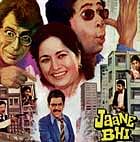
You’ve probably heard this before, but at the risk of sounding old and fuddy-duddy, I’ll say it one more time: Laughter is the best medicine. It’s free (mostly) and I’d like to think that it can be obtained from more than one source. Kids, if you have them, are a great one. But if your ears aren’t continuously being assailed by kid-speak, I’d say you need a trip to the movies.
Old or new, cinema has always appreciated humour. Just as we do in real life. It lightens the mood, eases the mind and un-wrinkles that forehead. It also, I am told, elevates your health quotient and generally improves quality of life. There’s humour, and wide varieties of it, to suit everyone’s taste. In real life and on film.
From the staid, steady and naturalistic treatment of comedy in the 70s and the 80s to the current crop of comedians, on-screen humour has come a long way. Back then, humour was of the story born. Films like Rang-birangi, Jaane Bhi Do Yaaron, Katha and Chasm-e-buddoor chucked humour at the common man, kindly and gently. The hero was the average Joe, solidly middle-class, at the mercy of his solidly middle-class life. And his life, oh his life, was a series of humorous travails.
Worthy veteran actors gave humour a new twist. From Sanjeev Kumar in his wonderful, light-hearted look at a twin-brother mix-up in Angoor, to Utpal Datt as the eccentric father in Hamari Bahu Alka, comedy was the emotion which sat resplendent in our hearts, and smiled naughtily from our eyes. From old school actors like Naseeruddin Shah and Ravi Baswani, to the relatively newer breed like Anil Kapoor and Amrita Singh (remember the delicious Chameli ki Shaadi?), to the very hip and modern Akshay Kumar, actors have regaled us with their interpretations of comedy.
Humour is very hard to portray on the big screen. The comic timing must be right and the dialogues smile-inducing. From my ebullient uncle who would unleash a guffaw at even the mildest of jokes, to my dour aunt, who rations out smiles like an expensive, hard-to-get commodity, everyone loves a good joke. And comedy films have the onerous task of producing them on demand.
Well, I am delighted to say that they do it and they do it well. Imaginative minds and talented script writers abound, humour in cinema is finding its rightful niche. Young directors like Dibakar Banerjee have brought to us wonderful films like Khosla ka Ghosla (2006), based on real-life housing troubles. Another film which was based on the quirky landlord-tenant relationship was the light-hearted Yeh Tera Ghar Yeh Mera Ghar(2001).
Directors like Rajkumar Hirani and Vidhu Vinod Chopra have kept us smiling with films like Lage Raho Munnabhai and the recent hit 3 Idiots. In Lage Raho... and its sequel, Hirani introduced us to the well-meaning humour of a lovable thug and his just as zany side-kick, Circuit. In 3 Idiots, Hirani tried a different tack, portraying the bumbling adventures of three friends who stand by each other in good and bad times.
Yes, humour is humour and I love it in all its forms. But what I particularly like in the current comedic ventures is the subtle infusion of humour in other genres of desi film. Humour has crept into filmi dialogues and acting. Romantic films like Jab We Met have an undercurrent of subtle comedy, and in it, Kareena Kapoor and Shahid Kapoor go gaga spewing lines designed for comedic effect. Similar is the whacky Pyaar ke Side-Effects with Rahul Bose and Mallika Sherawat giving as good as they get. In the offbeat romance, Cheeni Kum, Amitabh Bachchan and Tabu use sophisticated humor to give voice to their inner-most thoughts.
Of course, humour is subjective, and my kind of comedy might not exactly crack you up. So it is wonderful that along with subtle humor, we also have the overt. In short: slapstick. The move towards slapstick caught speed with the Aamir and Salman Khan starrer Andaz Apna Apna. It continues in films like Partner, Welcome, Golmaal, and the most recent Houseful.
Actors like Govinda and Paresh Rawal revel in comedic roles which seem written with them in mind. In Maalamal Weekly, which seemed like a whacky Wodehouse-ian comedy of errors, Rawal plays a short-sighted opportunist panting after ill-gotten wealth. And actor Kaykay Menon — who is generally not known for his comedic roles — excels in the 2009 con-man tale Sankat City which fused comedy with the crime genre. Bheja Fry, which featured Rajat Kapoor and Vinay Pathak, laughed at annoying people with obsessive compulsive behaviour.
In the recent Jaane Kahan Se Aayi Hai, a rather shapely alien visits the earth, and director Milap Zaveri tries a mix of sci-fi and fantasy to milk the (rather crude) humour. Humour, of and by Indians settled abroad, is what made the wonderful low-budget Shabana Azmi-starrer Loins of Punjab stand out. And probably what will work for Gurinder Chaddha’s most recent production It’s a Wonderful After-life.
Art imitates life. Just as everyday matters are better with a smile, so also on celluloid. Movies offer us a break from the humdrum routine of our lives. Comedies better that promise by leaving us smiling at the end of it all. So here’s to merry movie magic!
AMODINI SHARMA